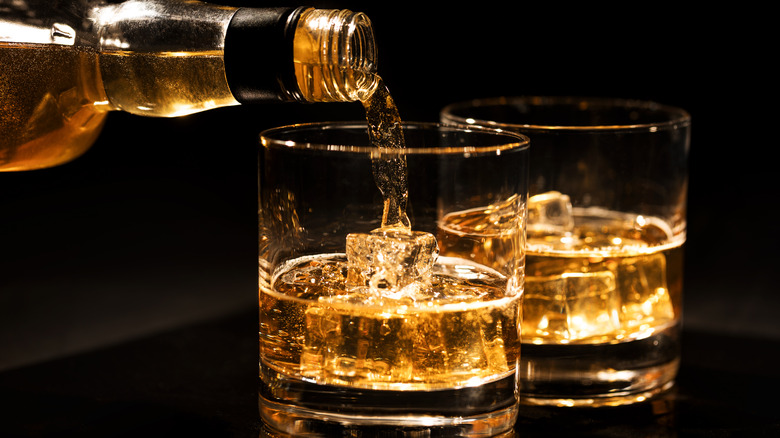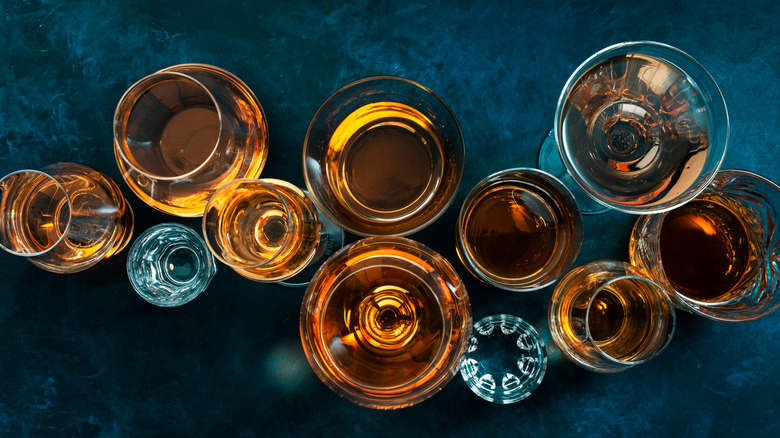The Clear Difference Between Scotch And Bourbon
Scotch and bourbon are tasty tipples renowned for their rich flavors, smooth finishes, and complex textures. But don't let their similarities fool you. Scotch and bourbon are two distinct types of whiskey, differentiated by their origin, production methods, and, of course, their distinctive tastes.
Both spirits are aged in oak barrels and have a rich, earthy flavor but diverge in their production process. Scotch is a barely-based beverage made exclusively in Scotland, while bourbon is strictly an American creation with a mash bill of at least 51% corn. The former is often viewed as the more mature option, with an often (but not always) gentle, peaty character that can only be produced from the Scottish highlands. Conversely, the latter is often associated with America's frontier spirit — boldly flavored, with a smoother, sweeter taste and slightly spicy bite.
The two spirits also differ in their aging period. Scotch is aged for a minimum of three years, and often much longer, in oak casks that have been previously used for spirits such as sherry, bourbon, or port. Bourbon follows the same general aging process but must spend at least two years in new, charred oak casks, which gives it a signature caramel and vanilla taste. Whether you're savoring the peaty richness of scotch or enjoying the sweet spiciness of bourbon, both are perfect for sipping and sharing with good company.
Discovering the distinctive tastes of scotch vs. bourbon
Scotch, a spirit hailing from Scotland, has a spectrum of flavor profiles ranging from light and sweet to smoky and earthy. These flavors stem from the malted barley, peat, and water used in production. For example, scotch from the Islay region, such as Laphroaig and Lagavulin, has a distinct smokiness that, according to Food & Wine, comes from the peat used to dry the malted barley, while the oak provides a subtle woody undertone. On the other hand, scotch whiskies from the Speyside region, such as Glenlivet and Macallan, are known for their lighter, fruity notes.
Bourbon (produced mostly in Kentucky) is made from corn, rye, and barley. The sweet mash, combined with the new charred oak barrels used in the aging process, imbues it with caramel, toffee, and vanilla notes. However, the added kick comes from the spicy rye grain, which can be tasted in high-rye bourbons, such as Bulleit and Basil Hayden. The proof, or alcohol percentage, also plays a significant role in the flavor profile, with higher-proof bourbons delivering a more intense flavor experience.
However, it's worth noting that scotch and bourbon have distinct varieties within their sub-category of whiskey, each with different ages and cask finishes that lend them specific tasting notes. Exploring the world of whiskey (or whisky in Scotland) is an endless journey of discovery, each glass offering a new adventure and a deeper understanding of the incredible flavor profiles found in each dram.
How to drink bourbon vs. scotch
Russell Greene, the bar supervisor at Castle Hot Springs' Bar 1896, told Travel & Leisure in February that it takes time to "develop an appreciative palate for whiskey," regardless of the variety. And glassware matters. "For whiskey neat, I have always loved the Riedel Single Malt glass — super fine crystal, clean lip, noses properly," Greene said to the outlet. "For on the rocks, a large tumbler is my go-to, something sturdy and heavy, with a nice lip." Most bars will serve bourbon in a classic tumbler, which allows the aroma to be distributed evenly. For scotch, a Glencairn glass is best. They feature a unique shape with a wide bowl and narrow rim that concentrates the aromas and directs them toward your nose. The design is also ideal for easy swirling.
When sampling bourbon or scotch, you don't want to gulp it down. Instead, take small sips and let them rest on your tongue for a few seconds. This will allow you to appreciate each spirit's different layers of flavor. Ask the bartender for one large ice sphere, as it'll melt the slowest and allow your drink to retain its original flavors for longer.
As for specific brands to sample, start with Knob Creek's 9-Year Kentucky straight bourbon or Woodford Reserve's Double-Oaked bourbon. Both are smooth and easy-drinking, with flavors of oak and spice. For scotch, try Glenmorangie or Aberfeldy 12, both excellent choices for first-time drinkers. Cheers!


